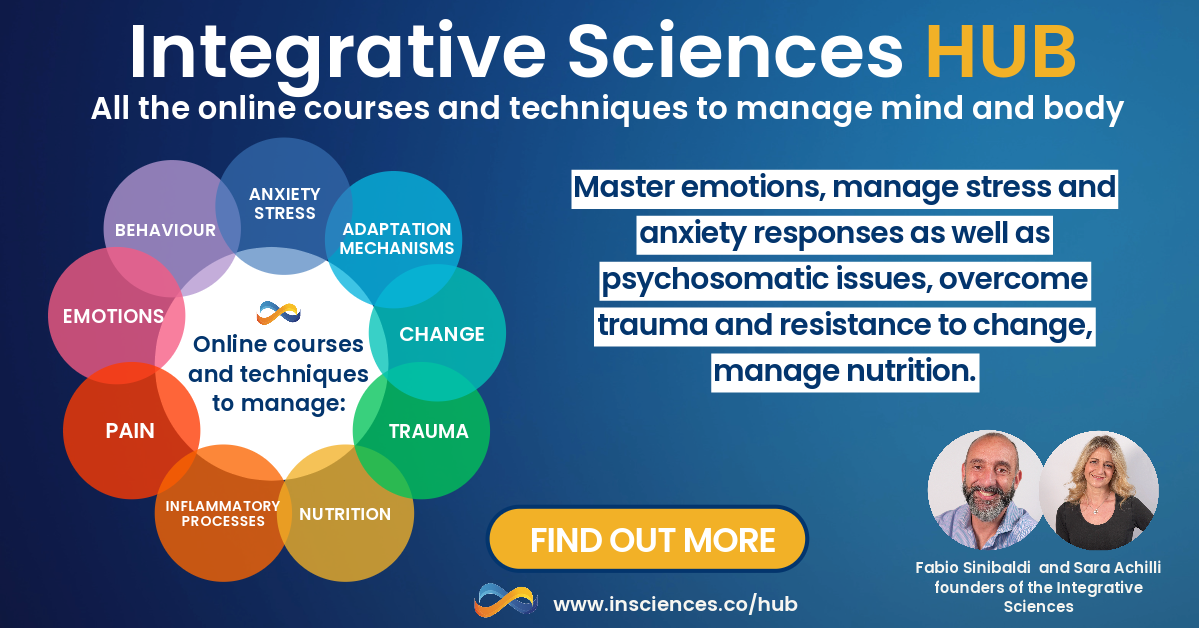
Navigating the Complexity of Headaches: an Integrated Approach across 4 Clinical Cases
Jul 25, 2023Headaches are an unwelcome companion for millions of people, with impacts that can drastically alter their lives. Therefore, understanding and navigating the complex world of headache types is essential. The world of headaches is complex and multifaceted, with a range of types, each with unique characteristics, triggers and treatment strategies. In this article, we'll delve into the nuances of headaches and present 4 illustrative clinical cases that highlight their diverse forms and how we can intervene in a tailored way.
Given the wide array of categories and theories surrounding headaches and cephalalgia, we'll bypass an extensive theoretical discussion in favor of diving straight into real-world cases. Instead, we will focus immediately on cases so that we can think more operationally about the different situations and what can be done in practice.
Case Study 1: Maria's Multifaceted Health Challenge
Maria is a 36-year-old woman of medium height with expressive, sad green eyes. Maria arrived looking exhausted, with a sense of frustration evident in her demeanour. Her main complaint was a recurrent severe headache that had started about two years ago.
On further investigation, it was found that Maria's headaches worsened during her menstrual cycles. Accompanied by mood swings, irritability, bloating and breast sensitivity, it seemed clear that her headaches were predominantly hormonal, part of a condition known as menstrual migraine. "Predominantly hormonal" doesn't mean, as we'll see, that only an endocrinologist can help her. We can support her in many different ways.
Maria also struggled with recurring episodes of cellulitis, a common bacterial skin infection. The patches of red, swollen skin on her lower legs caused her additional discomfort and contributed to her fatigue. It also caused some significant interpersonal problems.
Maria's management plan required a multi-dimensional approach.
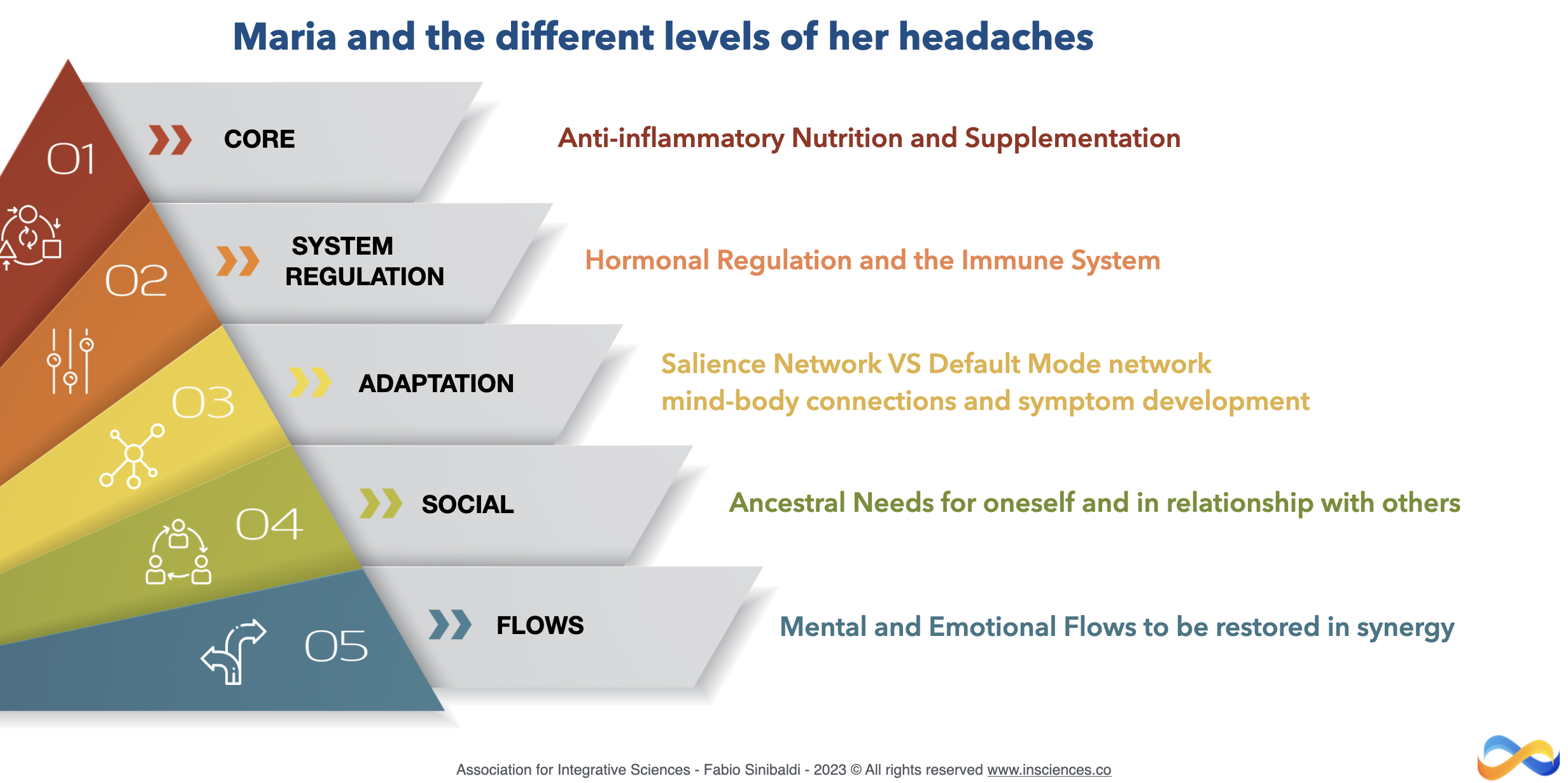
From our integrative perspective, her hormonal fluctuations and recurrent cellulitis indicated a state of chronic inflammation that was exacerbated during certain peaks of her hormonal cycle. An integrative nutritional approach in cases like this may consider supplements such as magnesium or vitamin B6 and zinc, which have been linked to hormonal balance.
The Mental and Emotional Flows model, in synergy with the knowledge of the brain networks behind it, was used to understand and manage her headaches. The Turn Your Mind technique (which reinforces the physiological switching between the Salience and Default Mode Network) supported Maria in understanding how her thoughts and emotions were physically affecting her body, causing stress and in turn increasing her PMS symptoms and headaches.
Nutritionally, a tailor-made ketogenic diet was recommended to help manage her immune response due to its anti-inflammatory benefits. Regular moderate exercise also improved her general health.
We also supported her in analysing her Ancestral Needs and how she was meeting them adequately (or not). There was a particular focus on the relational needs that were related to her symptoms, both as a cause and as a consequence.
Case Study 2: David's Echoes of Physical and Emotional Stress
David is a tall, robust 45-year-old man with short-cropped grey hair and a weary smile. A former college athlete, David had suffered several injuries in his youth. Recently, he had been experiencing headaches, which he initially dismissed as a byproduct of his stressful job.
After some digging, we noticed that David's headaches were triggered by his morning exercise routine. In addition, the residual effects of his old injuries manifested as post-traumatic headaches. His stressful job acted as an amplifier of his symptoms, creating a feedback loop of pain and stress.
For David, managing his headaches required a comprehensive approach. Physiologically, his exertional headaches could be caused by increased blood pressure during intense exercise. Moderating the intensity of his workouts, along with warm-up and cool-down periods, helped to alleviate this.
For his post-traumatic headaches, an integrated mind-body approach was crucial. He introduced two daily sessions of Isometric Emotions* to release systemic tension and rebalance the sympathetic and parasympathetic nervous systems and their associated muscle chains. We also introduced a few sessions with the RePro* app and techniques to dissociate some old bad postural habits from the traumatic memory that kept dysfunctional adaptive schemas active. [*included in the HUB]
From a mental perspective, simple exercises such as Parallel Worlds and Possible Scenarios more on helped David to understand and manage the stress of his job by breaking the anticipation and feedback loop between his physical and psychological state.
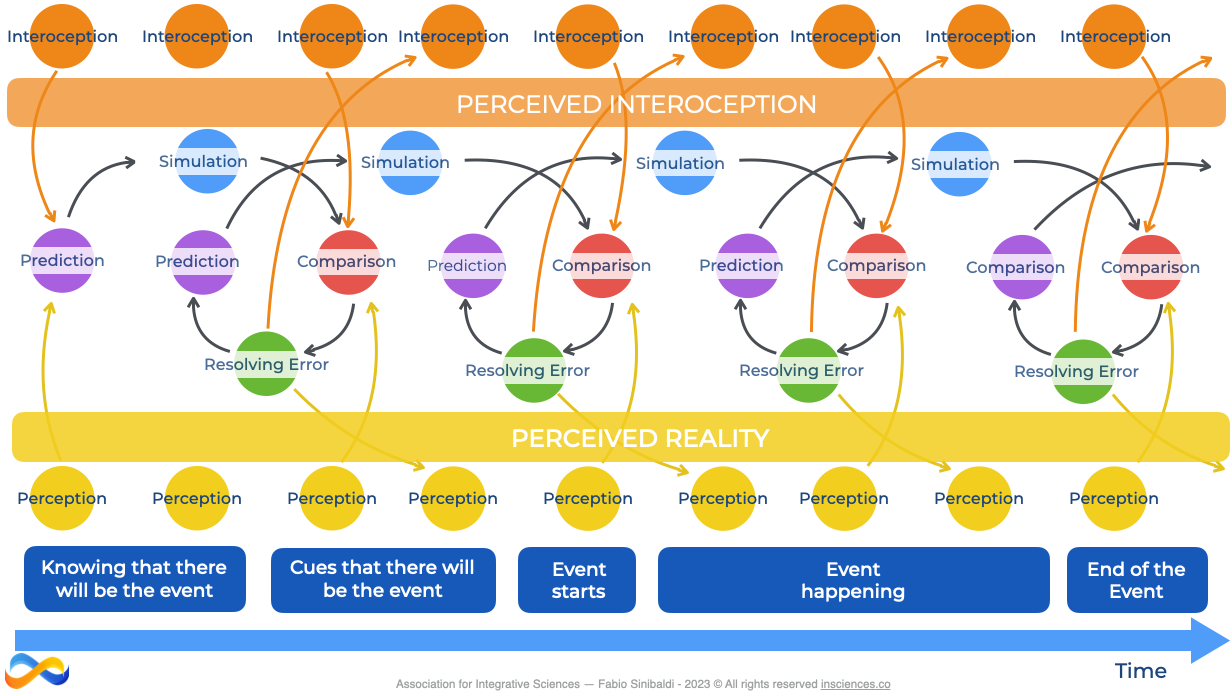
Given his active metabolism and old injuries, we worked in a targeted way to promote epigenetic change. This is the deepest level where memories are written and if the epigenetic markers are easier to change, any intervention ( be it physical, mental or emotional) will be easier to achieve and longer lasting.
Case Study 3: The Shy Teenager
Emily, a 17-year-old girl with sparkling blue eyes and curly blonde hair, hid her beauty behind a veil of shyness. Emily had started having migraines around the same time she hit puberty.
Emily's migraines, coupled with her introverted nature, led her to withdraw from social interactions, particularly at school. As her headaches became more frequent and severe, she also began to miss school. So Emily's headaches were not just a physical problem, they were having a significant impact on her social life and mental health.
Emily's treatment strategy involved several areas. Her migraines could be exacerbated by the stress and social anxiety she experiences at school, so we suggested the Facing technique to help her confront others (and her anxiety).
We also helped her to develop more somatic awareness and acceptance of her body. We used various techniques such as Interpersonal Accommodation (to help her find her safety distance from others), Fine Tune Regulation (based on micro-movements to regain a sense of self-control and self-integrity), Visual Analysis of Behavioural Flows and Needs (to be more objective about her agency, mastery and impact on others).
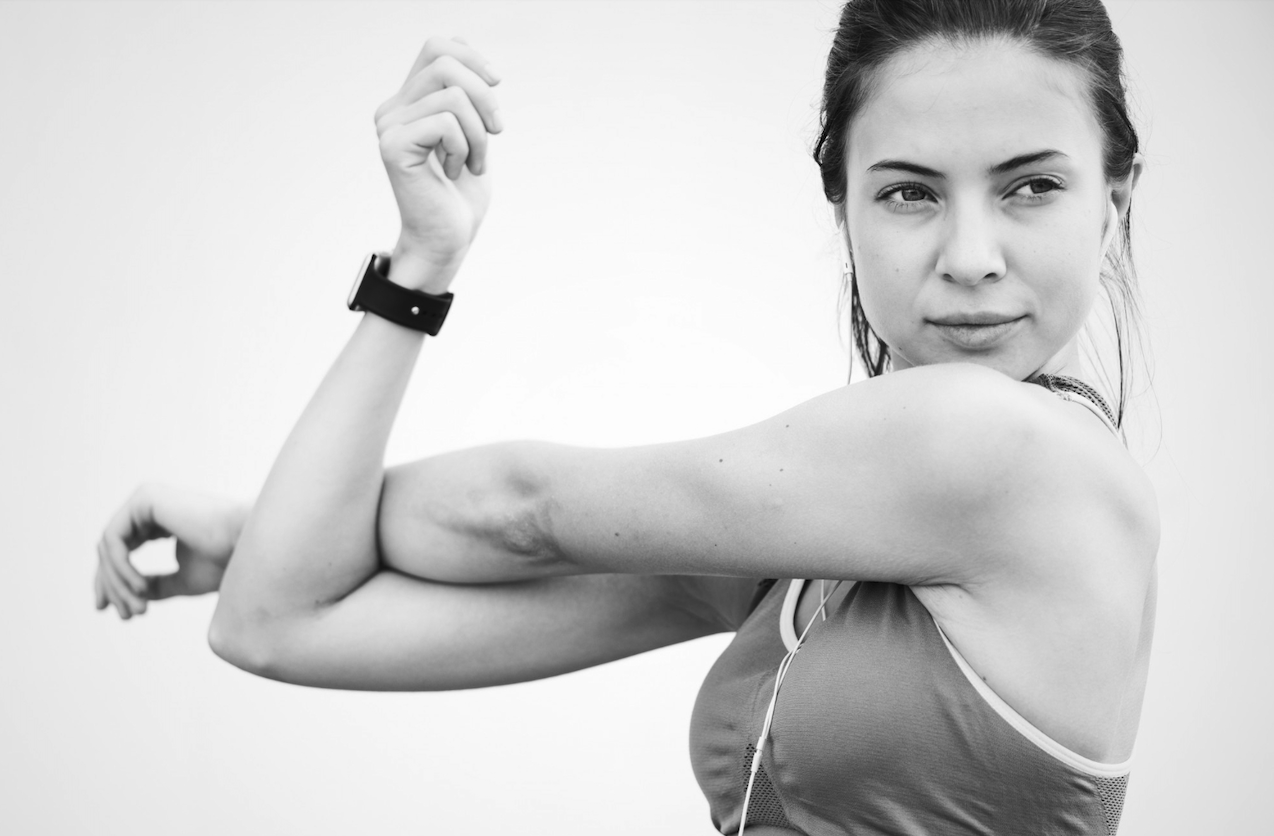
Emily's migraines are linked to the hormonal changes that occur during puberty, and her diet is likely to play a concomitant role. We can help Emily switch to a more anti-inflammatory diet, which will reduce her migraine symptoms and improve her overall health.
Case Study 4: A Student in a Foreign Country
Alex is a 24-year-old foreign student with a gentle demeanour. Eager to broaden his horizons, Alex relocated to a new country for his studies and took up part-time work to support himself. Soon after, he began experiencing tension headaches, which he attributed to stress and a drastic change in his diet and sleep patterns.
Alex also struggled with homesickness, which added to his stress levels. The unfamiliar weather patterns in his new country also seemed to trigger his headaches.
Indeed, from an integrative perspective, Alex's tension headaches are easily identified as symptoms of wider issues such as stress, dietary changes or disrupted sleep patterns.
From a metabolic perspective, we can see how his dietary changes are affecting his gut health (via the gut-microbiome-brain axis), which is closely linked to mental and physical health and well-being.
We proposed a tailored low-carbohydrate, high-fat diet designed to stabilize his blood sugar levels and curb inflammation, aiming to alleviate his headache symptoms and bolster his mood.
On the other hand, we can help him to cope better with stress and to develop a balanced lifestyle. Specifically, we targeted the uncertainty network and the prediction system to help him develop a broader and more flexible attitude.
Circadian rhythms are fundamental to good health and mood. We helped Alex establish a healthy sleep routine and use technology more wisely at night (considering both the effect of cognitive effort on brain activation and the effect of blue light from screens on the suprachiasmatic nuclei).
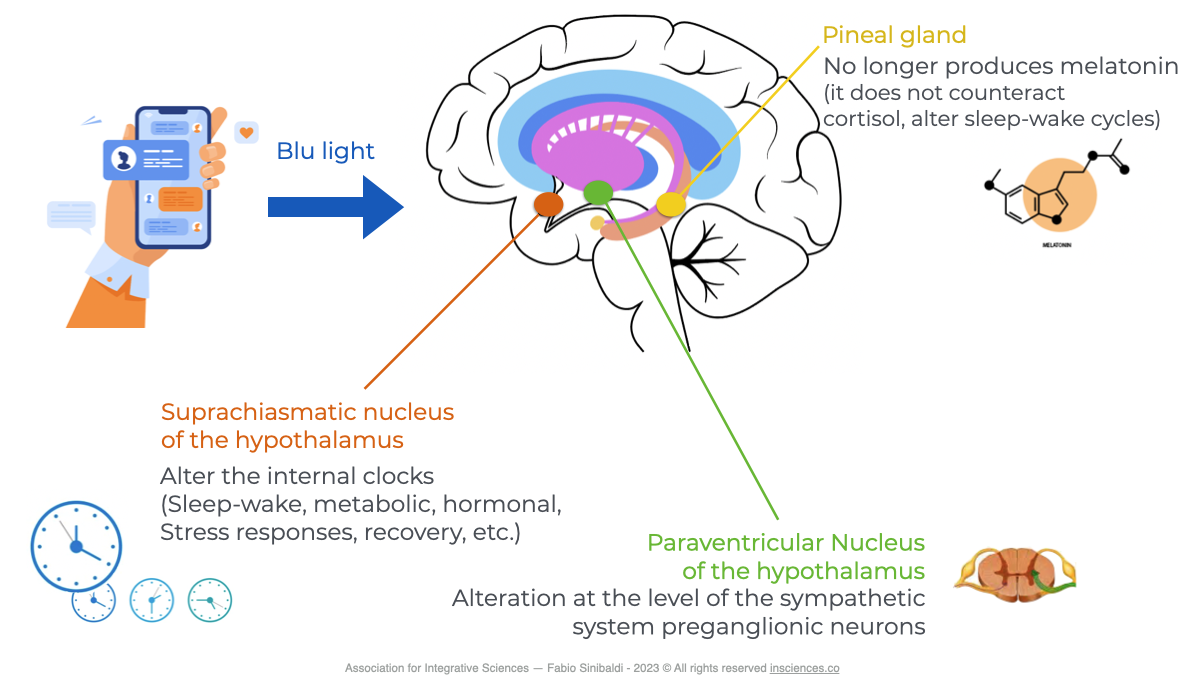
The Integrative Mindfulness practices and the exercises from the Brain-informed Tasting & Cooking method helped Alex to become more resilient to the stressors of his new environment and more. In fact, he was able to better appreciate cultural differences and developed some interesting skills that were helpful in social contexts.
He had only a small amount of physical tension involved in his psychosomatic processes. We suggested that he practise the Crossed Cycles Breathing Technique for 5 minutes a day. In this way he was able to quickly release the muscle tension associated with his headaches.
Navigating the Labyrinth of Headaches
These diverse case studies underline the fact that headaches often manifest as a result of a complex interplay of physical and psychological factors. Understanding this multifaceted nature is crucial for healthcare providers, enabling them to devise personalized, effective treatment strategies.
Moreover, it reinforces the importance of comprehensive patient assessment and open patient-practitioner communication. Patients, too, can better understand their condition's nature and manage it more effectively with this comprehensive approach.
Do you want to find out more?
Discover the many online courses on psychosomatic processes, regulation of anxiety and stress responses, emotion modulation, trauma and resistance to change. They are all part of the Integrative Sciences HUB, our regularly updated online training centre, available to you 24/7 with new COURSES, UPDATES, TECHNIQUES AND PRACTICAL TOOLS each month.
Stay connected with news and updates!
Join our mailing list to receive the latest news and updates from our team.
Don't worry, your information will not be shared.
We hate SPAM. We will never sell your information, for any reason.

